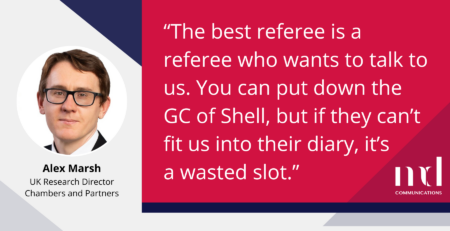Client referees are essential for legal directory research. MD Communications’ Director of Content Anthony Notaras and Partner Linsay Leslie assess the value that the Chambers & Partners’ Referee Management Tool brings to a notoriously tricky process.
Whether you’re a law firm or a lawyer, for positive momentum in the legal directory rankings, positive referee responses are essential. Good referees are the differentiator between just-another-submission and hey-check-out-this-firm (unfortunately the same applies to bad referees).
To understand the value of referees, imagine a directory researcher faced with a wall of Corporate/M&A submissions all containing transactions in the 50m-100m value range. How can they objectively judge one mid-size, mid-market deal to be better than another similar sized deal?
Truth is, they will find this extremely difficult without additional context and information.
The main distinguisher in this scenario must be quality of service, and the only measure of that comes from the referees. The firm with lots of friends will get the promotion while Norman no mates goes nowhere. Even if there’s not much to separate their submissions.
The same principle applies to individual lawyers struggling to get noticed in the department of a mega law firm. How do they stand out from their peers who, from analysis of the submission, all appear to be doing similar work?
Again, referees.
Oi ref!
The challenge then is finding and managing them.
Many lawyers dread the prospect of asking clients to be their referees. In our experience at MD Communications, the reason for this is largely because they make it a once-a-year chore. At which point the client might rightly reply, ‘Oh, so now you’re picking up the phone’.
To counter this, we recommended a dose of enlightened self-interest. A regular quarterly check-in with the client to find out how they are doing (and how you can make things better), will make that eventual directory referee request that much easier. It also raises the likelihood of them giving positive feedback about your proactivity, thereby reducing the likelihood of you having to chase them for responses.
Respond and deliver
Knowing whether a referee has received and engaged with a request from the directories is another cause of heartache, both for the researchers fielding lots of queries from anxious law firms, and for the law firms themselves who would rather not blindly harass busy clients.
This all changed in July 2022, when Chambers & Partners launched its Referee Management Tool (RMT), allowing users to monitor the contact status of all their referees. Those with access to the RMT (which comes as part of a paid-for Chambers package), now have a far greater ability to harness the power that referees can bring.
Updates to the tool have enabled greater functionality, including the ability to analyse previous research cycles to help make informed choices about their future referees (eg: more responders, fewer ghosters), and how to avoid using individual referees across multiple submissions.
At MD Communications, we are also working with smart firms using the RMT data for more than rankings. Updates to the RMT also make it a valuable source of data for firm-wide client relationship programmes, including as an early warning system, flagging any relationships that might be going off the boil and requiring love and attention.
Planning ahead
As with all aspects of the directory research process, careful long-term planning rather than panicked last-minute rushes bring far greater success.
Rick Jakubowski, Senior Product Marketing Manager at Chambers, sees this in the way law firms use the RMT.
‘Some firms are uploading referee spreadsheets early to identify any potential problems and deal with them well ahead of time,’ he says. ‘For example, if there are people the firm put forward as a referee who cannot be contacted because they have unsubscribed from Chambers emails in the past, this can be resolved well in advance of research starting.’
He adds: ‘The ability to see historic data on who the firm used as a referee in previous years and how often Chambers was able to make contact with them can help spot when referees might have been overused or may be getting fatigued and beginning to disengage. This can be a good sign to give this person a rest and instead ask somebody else to take part, who may have fresh insight to share.’
While some might fear the RMT creates more work for law firms, Jakubowski recommends a light touch approach. ‘Checking the tool weekly or bi-weekly seems to be what works best for our users,’ he says. ‘That leaves enough time for things to progress whilst also being frequent enough to act in a timely and decisive way when needed.’
Careful use typically does result in an uptick in referee contact rates. Jakubowski says: ‘Checking the tool just after halfway through the research dates for each section has proved very effective for firms. Sending targeted follow ups to referees that have the status Action Required: No Reply, has proven effective in boosting contact rates with referees that had most likely intended to share their feedback with Chambers, but had simply not yet had the chance or had forgotten to respond due to a busy schedule.’
Looking for likes
Cost may be a barrier to entry for some, but anything that eases the process for you and the clients should bring rewards – particularly in a process where favourable feedback might tip the balance between Band 2 and Band 3, or ranked and unranked. Even if it doesn’t result in a promotion, there’s no denying the dopamine hit that comes with an effusive client quote.
After all, everyone likes to be liked.
To find out more how we can support your directory submissions, take a look at our website or get in touch with Linsay.
📣 Linsay Lesley, Partner and Head of Legal Directories, Bids and Awards, will be speaking at on a panel about referee management at the Chambers 360 event at the Law Society on 25 September.












